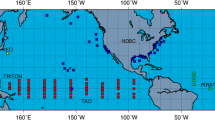Abstract
The monsoon sub-programme of FGGE deployed a variety of observing systems such as research aircraft, research vessels, floating ballooms, and a geostationary satellite, etc. during the special observational period of Monex-79, with a view to making the best possible data set available for studies on various aspects of the monsoon circulation. Whether the data obtained from the various observational platorms improve the representation of the monsson systems, flow patterns, etc. in the analysis is the basis of this study. For this, the objective analyses of the wind field were made with different data sets, first using only the data from conventional observation platforms, subsequently including the data from aircraft and ships and then finally including the data from the satellite. These analyses were compared with carefully made subjective analyses.
It is inferred that the addition of data has a positive impact on the objective analysis and the improvement in the analysis is more marked in the data-void region like the Arabian Sea compared to the region where observational stations are distributed fairly stisfactorily. It is also inferred that the impact of the aircraft/ship data on the analysis is more consistent than the data from the satellite.
Similar content being viewed by others
References
Cressman, G. P. (1959),An Operational Objective Analysis System, Mon. Weath. Rev.87, 367–374.
Crozet, P., Desbois, M., Semery, A., andSitbon, P. (1979),Champs de vent déduits des déplacements des nuages mesurés à partir d'images successives du satellite géostationnaire GOES I.O. au-dessus de l'Océan Indian, Note LMD No. 97, Sept. 1979, Laboratoire de Meteorologie Dynamique, Paris, 1–212.
Haslar, A. F., Skillman, W. C., Shenk, W. E., andStrenka, J. (1979),In situ Aircraft Verification of the Quality of Satellite Cloud Winds over Oceanic Regions, J. Appl. Met.18, 1481–1489.
Krishnamurti, T. N., Greiman, P., Ramanathan, Y., Pasch, R., andArdanuy, P. (1979),Quick Look Summer Monex Atlas, Part II — The Onset Phase, Florida State University, Report No. 79-5, 1–205/
Young, J. A., Virji, H., Wylie, D. P., andLo, C.,Summer Monsoon Wind Sets from Geostationary Satellite Data (University of Wisconsin, Madison, USA 1980), pp. 1–127.
Author information
Authors and Affiliations
Rights and permissions
About this article
Cite this article
Rajamani, S., Talwalkar, D.R., Upasani, P.U. et al. Impact of Monex-79 data on the objective analysis of the wind field over the Indian region. PAGEOPH 120, 422–436 (1982). https://doi.org/10.1007/BF00879827
Received:
Revised:
Issue Date:
DOI: https://doi.org/10.1007/BF00879827



